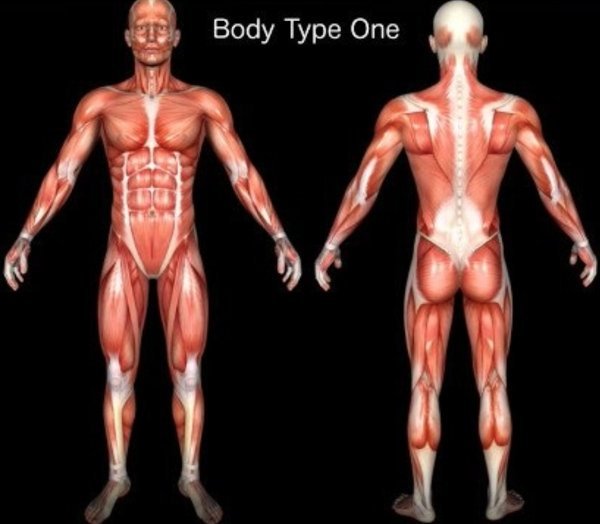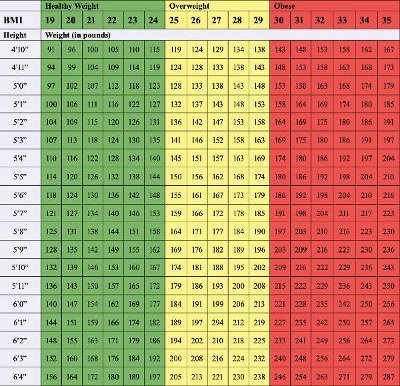
Most people do not realize that the somatotype three body types – endomorph, mesomorph, ectomorph – are not based on science. They were thoroughly debunked long ago. When visiting your medical doctor for your regular check-up, just like every human being, your body and health are judged by no less than the following three current scientific body type standards to determine if you are, indeed, healthy and “normal.”
Current Scientific Body Type Standards
Standard #1 is the Standard Scientific Human Body Anatomy Book Body Type (BT1) found in any scientifically approved human body anatomy book with all muscles/muscle mass fully developed, no less. According to mainstream science and medical doctors, every human being is born in a Standard BT1. Even if you are diagnosed with an abnormality like scoliosis or Poland’s Syndrome, you are still a BT1 just with a specific diagnosis. The BT1 is not accurate because it fails to take into account genetics and skinny fat (cellulite, thin fat, loose skin, saggy skin, creepy skin, normal weight obesity).
The Standard Scientific Human Body Anatomy Book Body Type One (BT1)
Standard #2 is the Body Mass Index (BMI), officially used since the mid-1980s. BMI is not accurate because it also fails to take into account genetics and skinny fat. It is further inaccurate because it does not calculate excess muscle/mass. For someone like Dwayne Johnson (The Rock), his BMI calculation likely places him in the overweight or obese columns of the Standard BMI chart weight scale, but he most certainly is neither.

Standard #3 is the basal metabolic rate (BMR), calculated through the Mifflin St. Jeor equation and Harris-Benedict formula for activity. Like the other two standards, the Standard BMR calculations do not incorporate skinny fat. Science recognizes that one pound of muscle burns six calories per day but one pound of fat/skinny fat only burns 2-3 calories, all of which affect metabolism. If you have skinny fat on your body where there should be muscle/mass but you are relying on the Standard BMR calculations, you are likely eating too many calories per day.
Gaslighting – Skinny Fat, Normal Weight Obesity, & Obesity
When I was eight years old, I was a star soccer player on a state championship team. During shirts-off practice and while swimming at the local pool I began to notice the skinny fat, especially normal weight obesity, all over my body where there  should be muscle/mass. Many of my peers looked like the Standard BT1 — I did not. Genetically, obesity is common in my family.
should be muscle/mass. Many of my peers looked like the Standard BT1 — I did not. Genetically, obesity is common in my family.
When I asked my parents and the doctor what was up with all the skinny fat, where was all the muscle a BT1 was supposed to have, and why I was so weak, they brushed it off. They said it will come as I grow and not to worry about it. It is impossible not to worry about being ruthlessly bullied while being gaslighted and called lazy and unmotivated by everyone, particularly my family. It destroys trust and confidence, at the very least.
As a late bloomer, when puberty finally hit, more skinny fat grew where there should be muscle/mass, contrary to the doctor’s adamant promises. I was forced to quit soccer and competitive sports in general as you cannot be an athlete without muscle. All of this was devastating as I loved soccer and sports as a whole.
Unfair Body Type Standards
Being so active in general on top of being consistent and diligent with my cardio and resistance exercise workouts made no difference. The skinny fat was everywhere and I could not get rid of it. To this day, there is no FDA-approved way to get rid of any form of skinny fat. Nevertheless, no doctor in my life has ever once offered any real explanation for my perpetual, copious skinny fat and severe lack of muscle.
All the same, I am relentlessly held to the three current inaccurate and unfair body type Standards – BT1, BMI, and BMR. Regardless of my undisputed feeble and scrawny body. In disregard of my rampant body-wide skinny fat and the fact that obesity is genetically common in my family.
Just like countless people in the world, I have been held to these unfair, inaccurate body type standards my entire life. Standards that my genetics and body type can never achieve. My extraordinary personal hard work to keep obesity at bay and remain healthy despite being normal weight obese has been thoroughly ignored due to the fact that the inaccurate BT1, BMI, and BMR are king.
Body Type Science – Improving Standards & Inaccurate Indicators
The relentless gaslighting by doctors, family, friends — everyone — has continued for forty years. All the while I am being told that I simply am not working hard enough because I am lazy and void of discipline. Yet, I have been within my safe BMI for the vast majority of my life while suffering continuously from normal weight obesity. This makes no sense and never has because mainstream scientists and medical doctors are steadfast that, unless diagnosed otherwise (which I have never been), every human being (notably anyone under the age of 40) is a BT1 with all muscle/mass fully developed once within safe BMI.
Why am I so different? And why is no one listening or addressing the problem, still?
At age 8 into my teens through my thirties, really, if I actually was a BT1 with all muscle/mass fully developed, then why should I have to build any muscle/mass? The thing is, then and now, BMI has always been inaccurate, hand-in-hand with the BT1 and BMR. Nonetheless, all three remain vital indicators doctors use to determine whether a body is “normal” and “healthy.”
Body Type Science tools like the Scientific Body Type Quiz are working to make body type standards more accurate, reliable, and fair.

The Evolving Definition of Obesity

Up until now, mainstream scientists and medical doctors have viewed obesity strictly as an energy imbalance. In other words, too many calories are consumed daily above your Standard BMR which takes you outside your safe BMI chart weight range columns (green) into the unsafe obese columns (red). The definition of obesity is having too much fat on your body.
Again, according to mainstream scientists and medical doctors, to lose the extra fat (calories) weight on your body and get back within your safe BMI to once again be a Standard BT1, all you have to do is clean up your diet to reduce your daily calorie intake to at or below Standard BMR for a long enough period of time. You can also increase calories burned through proper exercise to expedite the process. Sounds simple enough, right?
But there are real problems with this approach that mainstream scientists and medical doctors cannot and refuse to explain. For one thing, there are countless people worldwide who, even when they are within their safe BMI, still experience some form of skinny fat including normal weight obesity, and do not look like the Standard BT1. For many more, this has been a fact since birth — they have never been or looked like the Standard BT1.
Moreover, there are many people globally who, according to the Standard BMI chart are overweight or obese, but all their other health-indicating factors including blood pressure, heart rate, cholesterol, blood sugar (A1C), etc. are normal. Which has led to the more recent scientific terms obesity paradox and metabolically healthy obese (MHO).
The Obesity Epidemic, Genetics, & Body Type Science Standards
The global obesity epidemic is getting worse. According to NIH.gov and CDC.gov, the prevalence of obesity in the US increased from 30.5%  to 41.9% over the last two decades. Severe obesity has increased from 4.7% to 9.2%. Furthermore, WHO.org reports that more than 1 billion people worldwide are obese, equating to 650 million adults, 340 million adolescents, and 39 million children. The scientific data clearly supports obesity being a dangerous disease that increases the likelihood of experiencing other serious conditions. Maladies such as heart disease, diabetes, gallbladder disease, cancer, and stroke along with reduced life expectancy are common.
to 41.9% over the last two decades. Severe obesity has increased from 4.7% to 9.2%. Furthermore, WHO.org reports that more than 1 billion people worldwide are obese, equating to 650 million adults, 340 million adolescents, and 39 million children. The scientific data clearly supports obesity being a dangerous disease that increases the likelihood of experiencing other serious conditions. Maladies such as heart disease, diabetes, gallbladder disease, cancer, and stroke along with reduced life expectancy are common.
Normal weight obesity, being within your safe BMI but still having too much fat on your body, carries with it many of the same risks as obesity. The overall annual healthcare costs associated with the disease of obesity are astronomical and unsustainable. Body Type Science is the key to real sustainability.
Future Health
Genetics determine scientific body type. Diet, exercise, and lifestyle also play crucial roles. As Body Type Science research grows and we better comprehend how genetics including skinny fat as well as diet, exercise, and lifestyle influence the human body, particularly in terms of shape and type, we will more clearly understand what it means to be a healthy human being.
This, in turn, will help improve the accuracy of scientific/medical standards and indicators, ultimately mitigating the obesity epidemic and improving aggregate human health in the short and long term.








